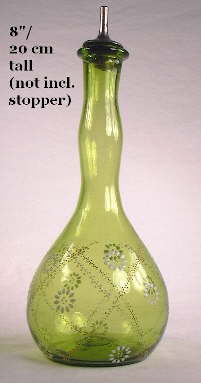
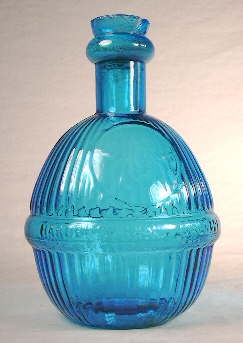
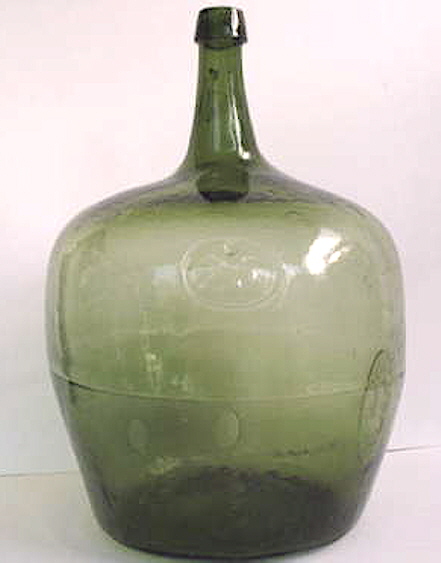
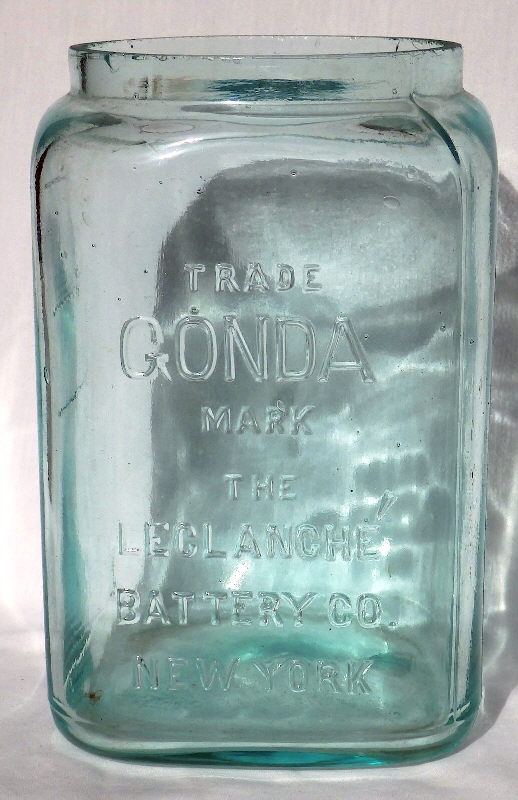
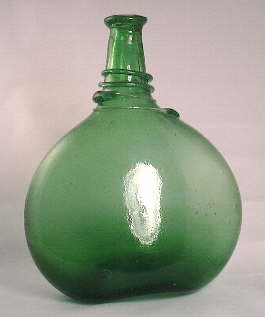
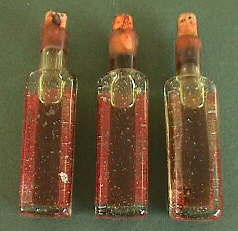
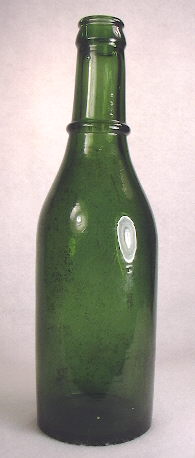
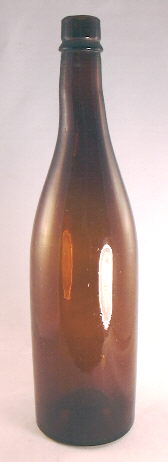
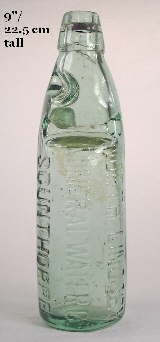
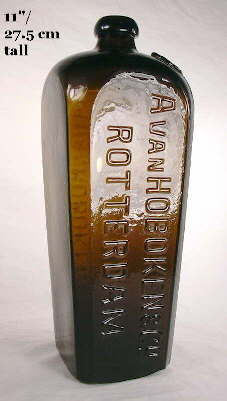
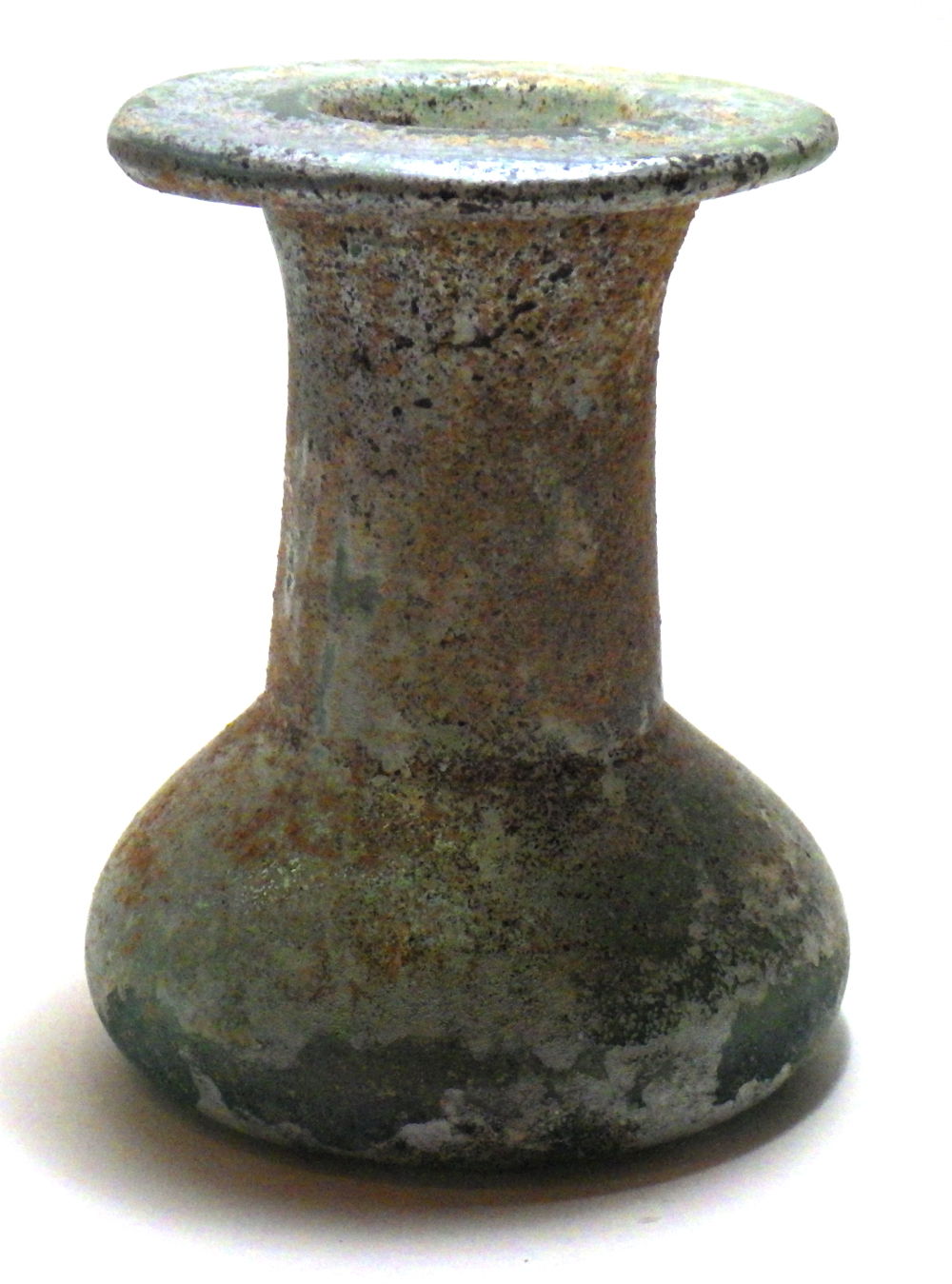
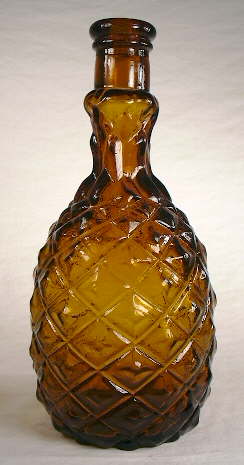
Bottle Typing/Diagnostic Shapes
Miscellaneous & Foreign Bottles
HOME:
Bottle Typing/Diagnostic Shapes:
Miscellaneous & Foreign Bottles
Click to move to the Organization & Structure Summary.
This Miscellaneous & Foreign bottles page is one of two typology pages (in addition to the Household bottles [non-food related] page) which largely comprise the "catch-all" sections for American-made bottles that do not neatly fit in any of the other major typology pages. This particular page also includes a smattering of foreign bottles which were commonly imported into the U. S. and Canada and likely to be found on U. S. and Canadian historic sites. It will also briefly address the subject of reproductions and modern (mid-20th century or later) "fantasy" bottles about which this author gets many questions.
This section of the typology pages probably doesn't need any further discussion or introduction; it just contains moderately significant categories that are not otherwise covered anywhere else within this website. The other typology pages (e.g., "Liquor/Spirits bottles", "Food Bottles & Canning Jars", etc.) have larger introductory sections than this page or the "Household bottles (non-food related)" page. This is because the "miscellaneous" and "household" categories are much wider ranging in diversity, lacking an overall binding "theme" compared to the other major categories. Instead, this page will have specific bottle type introductions incorporated into the opening paragraphs within each given section listed. Given this structural difference, the introduction for this page is considered complete; please scroll down to the "Organization & Structure" section below to begin.
|
Bottle Typing/Diagnostic
Shapes: This Miscellaneous & Foreign Bottles page is divided into the following categories and sub-categories based largely on the different contents that each group held, and within those groups, by various dominant shapes or other logical categories. Additional categories and/or sub-categories will almost certainly be added as future updates to this page. -Chinese/Asian
bottles Each of the pictured bottles has a relatively short description and explanation including estimated dates or date ranges for that type bottle and links to other view pictures of the bottle. Additional links to images of similar bottles are also frequently included. The array of references used to support the conclusions and estimates found here - including the listed dating ranges - are noted. Additional information and estimates are based on the empirical observations of the author over 50 years of experience; this is often but not always noted. Various terminology is used in the descriptions that may be unfamiliar if you have not studied other pages on this site. If a term is unfamiliar, first check the Bottle Glossary page for an explanation or definition. As an alternative, one can do a search of this website. To do a word/phrase search one must use the "Search SHA" boxes found on many of the main SHA web pages, including the Research Resources page (upper right side of that page) which links to this site. The Historic Bottle Website (HBW) has no internal search mechanism so be aware that when running a search one will also get non-HBW response links to other portions of the SHA site. |
|
"During the last fifty years of the nineteenth century, when many men went to barbershops for a shave as well as a haircut, it became the custom to provide special customers with personalized shaving mugs and hair tonic bottles. In addition, each barber had his own set of two bottles of tonic for other than special customers, and a matching bowl. Some barber bottles could be more properly called dresser bottles because they were used in the home... "The tonics kept in these bottles were bay, witch hazel, "Tiger Rub" (perfumed alcohol, and a variety of liquids with such appealing names as "Lilac," "Rose," and "Spice." Some of these tonics were commercial products and some were made by the barber himself. The 1906 Pure Food and Drug laws prohibited such personalized mixtures (*See note below) and restricted the manufacture of some commercial products. This coupled with the success of King Camp Gillette...in marketing the safety razor in 1903 (which reduced daily trips to the barber, brought about the death of barber bottles in both the shop and the home." (*Authors note: As noted at the 1906 Pure Food and Drug laws link, until the 1912 passage of the Sherley Amendment to the 1906 Act, enforcement of the Pure Food and Drugs Act was limited at best. Even then, enforcement was a process that took years to make a difference.)
The bottle pictured to the right above is an opalized (white details) and frosted (between the white) "daisy and fern" design dating from the 1890s or early 1900s, and possibly American made (Holiner 1986:78). It has a smooth base (not pontil scarred) but otherwise exhibits a hand-made, art glass quality manufactured look. It also has a sprinkler top still in place. The following barber bottles give some idea as to the variety possible in both shape and colors. These bottles date from the 1885 to 1920 era and are provided compliments of Glass Works Auctions. There were likely thousands of different variations of these bottles made during the era noted above.
Dating summary/notes: As a
specialty bottle type, barber bottles will rarely follow the dating
rules based on manufacturing related diagnostic features as discussed on
this website. They are really a form of art glass where older hand
processes continued until well into the 20th century. For example, an
amber glass, floral Art Nouveau style barber bottle with a pontil scar shown
in Holiner (1986:54) is specifically illustrated in the previously noted
1915 Koch & Sons Barbers Supply catalog as available in "eleonor-green,"roman-gold,
and sky-blue" (Holiner 1986:119). The best source of information,
including scores of colored images and excerpts from barber supply catalogs,
is "Collecting Barber Bottles" by Richard Holiner (1986).
Freeman (1966:370-371) also covers the subject and there is an article
(which the author has not seen) entitled "Barber Bottles" in the
Western Collector Magazine (January 1966) by Otha Wearin that may
be of use. |
Return to the top of this page.
|
Fire Grenades
"Early in the 1870s, it became popular to have round glass bottles filled with carbon tetrachloride stationed at critical points in homes, businesses, trains, and other appropriate places. These bottles were designed to be thrown into fires, where the impact would shatter the bottle, spill the carbon tetrachloride*, and extinguish the fire. It is not known who was the first to invent this ingenious method of extinguishing fires but it is known that the first American patent granted for a fire "extinguisher"** was awarded to Alanson Crane of Fortress Monroe, Virginia in 1863." (*Other chemical solutions were also used like the carbonic acid noted below. **Alanson Crane's patent #37,610 was for an "Improvement in Fire-Extinguishers" which was a water pipe and sprinklers system for buildings, not a throwable and/or breakable container.)
The 1871 patent (#117,891) was issued to Samuel B. Johnson of Philadelphia, PA. for the concept of a breakable ("...constructed of metal, glass, or other material suitable for the purpose intended..."), fire extinguishing "grenade" that could be hurled into a fire to put it out. Johnson did note that "It is preferable that the vessel be in the form of a grenade or bomb, and constructed of glass, that it can be easily thrown or discharged, and break when it strikes the spot against or towards which it is intended." The 1883 patent (#282,981) was issued to John J. Harden of Chicago, IL. for a "Hand-grenade for Fire-extinguishers." Apparently, Harden acquired rights to Johnson's 1871 patent for a throwable glass grenade, but refined his product further with the 1883 patent which was basically for a glass bottle with a specific finish and seal. Click view of the neck and finish to see a close-up of the grenade's neck, finish and closure which still retains the cement seal - which fills the length of the neck also - and most of the original contents (some evaporation through the seal). The patent was for - "A hand-grenade for fire-extinguishing purposes, consisting of a receptacle formed of glass or other frangible, material and having an orifice provided with a stopple fitted therein, the stopple being provided with an interior recess opening into the interior of said grenade, containing the requisite acid and alkali, forming a charge of carbonic-acid, or other fire extinguishing gas, said orifice being also provided with an enlargement above said stopple, and ending with an inwardly-inclined flange...". This translates from that patent-speak into a throwable glass bottle ("grenade" which was not specifically patentable at that juncture in time) with the unique finish shape and cement seal ("stopple") as shown (which was patentable).
The turquoise blue fire grenade pictured to the left is a Hardin's fire grenade variation, most likely a bit later in manufacture (early 1900s) though mouth-blown manufactured in the same fashion as the example above. It is about the same size and dimensions as the example above, but differs in the body design which is numerous vertical ribs broken in the middle by a protruding body encircling band. The band is embossed with HARDEN'S HAND GRENADE FIRE EXTINGUISHER and on one shoulder side has the word STAR inside a star in a circle, the same as found on one side of the earlier discussed bottle. There were many other types of fire grenades made in various shapes from the 1870s until 1920s or later; see Munsey (1970:196-197) to view a more types illustrated there. This author knows of no book dedicated to the subject although there is some information and additional images of these type bottles in Freeman (1964:350-351) and Ferraro (1966:63-67). A few additional 1870s to 1910s "grenades" are listed as follows:
Dating summary/notes: The dating of these type bottles based on manufacturing
related diagnostic features closely follow the guidelines
presented throughout this website and summarized on the
Bottle Dating page; see that page for more information. There are no significant bottle type specific, manufacturing related
diagnostic features or dating trends that have been noted by the author
with one exception. There is a strong trend in these bottles
towards having cursory, crude and largely untouched (slightly ground
down) "cracked-off" finishes, like the two examples illustrated here.
This isn't as much a dateable feature as almost a finish style that is
virtually only found on mouth-blown fire grenade bottles; a feature of
possible use in fragment identification. |
Return to the top of this page.
|
Carboys & Demijohns
A few of the references consulted noted either a functional or design differentiation between these two large bottle names. For example, Odell (2008) mentioned that functionally "Demijohns were for potable and non-corrosive liquids" with "carboy contents...strong chemicals - mostly acids." Munsey (1970) noted stylistically that "Demijohns were usually manufactured in a bulbous or bladder shape and have rather long necks; carboys, on the other hand, were generally cylindrical in shape and had short necks." For example the large olive green bottle to the left would be a "demijohn" with the 5 gallon bottle illustrated to the right below being a "carboy." The latter "carboy" shape has been commonly used for drinking water - a decidedly potable and non-acid liquid - from at least the early 20th century to the present, though typically plastic bottles today. (In fact, the 5 gallon "carboy" illustrated below right - and from a 1920 bottle makers catalog - is labeled as a "water bottle.") To add to the confusion the 1906 Illinois Glass Company catalog scanned and located on this website shows a listing for a cylindrical, short neck "demi-john" (page 110) and a bulbous/bladder shaped "carboy" (page 112) - the reverse of Munsey's styles differentiation. For simplicity sake, the term demijohn is largely used here for all large capacity glass bottles.
Demijohns were typically covered tightly with wicker for protection, i.e., covered with woven thick grass (including bamboo), reeds, sedges, and/or in particular, narrow willow twigs; leather was also sometimes used. The process was called "wickering" not surprisingly (Soetens 2016). Such large glass bottles, especially when full of liquid and heavy, were quite fragile and easily broken with even minor bumping against each other or any hard surface. The wicker covered example to the right is of a bladder shape similar to the olive green demijohn above. Click group of three wicker covered demijohns to view wicker covered demijohns ranging from about a gallon to about five gallons. Click U.S. Patent No. 348,665 to see an 1886 patent for a base related innovation for applying wicker to a demijohn. The shape of demijohns were typically like those shown in this section largely because these shapes were the easiest to cover quickly and effectively with wicker; essentially a mandatory requirement for proper protection. The wicker work was typically done by children, including girls, inside the glass factories or outside as contracted work (including with orphanages). This was one of the rare documented instances in the 19th century of females being regularly involved in the manufacturing of bottles (Odell 2008).
The large oval/bladder shaped demijohn pictured at the top of this section is a mid-19th century, mouth-blown, most likely European made example. It holds at least 5-6 gallons, was blown in a 3-piece mold, has a large applied "oil" type finish, and likely is pontil scarred in some fashion. A demijohn of this size certainly spent its useful life covered in wicker to have survived breakage, though the wicker was removed (or rotted off) at some latter point in time and then stored away for decades. Demijohns of various shapes and sizes are commonly encountered today as they were usually reused for many years and not disposed of unless broken, often being stored away and forgotten. The wicker being dried vegetation most often fell apart with time though examples with wicker (images above) are not uncommon if the demijohn was stored in a dry place like an attic or cellar.
Dating summary/notes: The dating of these type bottles based on manufacturing related diagnostic features roughly follow the guidelines presented throughout this website and summarized on the Bottle Dating page; see that page for more information. There are, however, several manufacturing related diagnostic features or dating trend trends that have been noted by the author that don't follow those found on smaller utilitarian bottles. The first is that these large bottles tended to be made by mouth-blown methods later than when a majority of most other bottle types were being made on machines. For example, the 1920 Illinois Glass Company catalog linked above notes that their new carboy factory in Alton, IL., completed in January 1919, had "...installed in it an Automatic Machine, the capacity of which is devoted exclusively to the manufacture of Carboys, Water Bottles and large Containers, ranging from two to twelve gallons." This implies that prior to that time the production of carboys and "large Containers" was likely still done by hand methods, aka "mouth-blown." In addition, Soetens (2016) noted that the first fully automatic bottle machine in Europe was first used sometime shortly after 1923. That author also mentioned that demijohns were still being produced by hand - i.e., mouth-blown - at least as late as 1950 in Germany. And finally, a recently noted YouTube video indicated to be filmed at Gayner Glass Co. (Salem, NJ) in the 1940s shows workmen still making demijohns by largely hand methods that late into the 20th century. (That video is available at the following link: https://www.youtube.com/watch?v=8CzMik9oelU&ab_channel=ricgrass ) Related to the above is the observations is that older bottle making methods were used much later on very large bottles as demijohns were were still being held for finishing with pontil rods after the general end date of around 1870 for smaller, utilitarian bottles (Jones & Sullivan 1989:45; empirical observations). The other bottle type specific dating irregularity noted is that mouth-blown demijohns tended to have applied finishes later than most other bottle types as well as being produced in molds with a post-base configuration mold later. Specifically, applied finishes are thought to have been used on mouth-blown demijohns - like the two amber examples to the above right - into the late 1890s and possibly early 1900s, which was well after most bottle types were having finishes formed by tooling. See the main Bottle Finishes & Closures page for more information. In a related fashion, post-base molds were used into the early 1900s with those types of commonly encountered demijohns, again well beyond the period that most other bottles (excluding many mouth-blown fruit jars and beer bottles) were being largely made in cup-base molds. See the post-base (aka "post-bottom") mold section of the Bottle Bases page for more information. So in summary, the dating of mouth-blown demijohns isn't the most exact science since they were produced that way for a very long time after virtually all other bottle types were being produced on automatic bottle machines.
The most useful references
known to this author on this genre of large
bottles - and leaned on heavily in the preparation of this section - are
noted below:
Soetens,
Johan. 2016. A Brief History of
Demijohns and Carboys. Antique Bottle & Glass
Collector, 33(4):32-35 (August 2016). As the title notes it is a brief history
of this class of large bottles though does include some very interesting images
including the process of applying wicker to the outside of these bottles - a
very common addition to protect these relatively fragile containers.
|
Return to the top of this page.
|
Battery jars
The fourth jar is entitled "Round Battery Jars - Flint. Turn Mold" which indicates these were made in a turn (or paste) mold and in only colorless glass. These were available in over a dozen sizes from a very small 4" x 4" (pint or so) to a robust "9 x 15" which would have been at least a couple quarts in capacity. Of course, most of the battery "contents" would have been the solid parts noted earlier surrounded by a electrolyte conducting solution bath. The inertness of glass to that solution is why these batteries were contained in glass even though that made them fragile. Offsetting the fragility of glass was that they were blown with at least moderately heavy glass thickness (empirical observations). This illustration indicates that three of the jars had perfectly round rims with one (lower left corner) having a "pour spout" and the name "Le Clanche Battery Jar"; more on that below. The square, aqua battery jar shown above is a proprietary battery jar which is embossed on the front with TRADE / GONDA / MARK / THE / LECLANCHE / BATTERY CO. / NEW YORK. On one side it has horizontal fill lines with the numbers "1 2 3" beside; click side view showing fill lines and numbers to see such. On the opposite side is an "M" embossed towards the base with the base having the number "2". (No images of the other side or base and no meaning known for the "M" or the "2".) It is 6 3/4" tall, 4" wide body sides, a wide mouth with a hand ground rim and no "pour spout and was mouth-blown in a cup-bottom mold. Not sure what the GONDA refers to though it was likely just a model/product name for that particular battery?
Based on the listings in this catalog, it seems the name "LeClanche" (or "Le Clanche") was attached to jars with this wire exiting rim feature as the other listed "no-name" jars do not have such a feature illustrated. This seems to indicate that the name "LeClanche Battery Jar" was a general name for that type of battery jar with a "spout," somewhat like the way "Scotch tape" is universally used for most clear, adhesive tapes. What the connection is between Mr. LeClanche and the LeClanche Battery Company is unknown. The company may have simply appropriated his name, being a foreign national, as their name?
It is not known for sure when glass battery jars were phased out although they are NOT listed in the 1920 or 1926 Illinois Glass Company catalogs so it appears that they were replaced by less fragile materials by about that time? This author has never seen a machine-made glass battery jar that is similar to the ones shown here, though such likely exist. For more information on the history of batteries, including battery jars, George LeClanche and more, search Wikipedia for the page entitled - "History of the Battery" (with no quote marks).
Dating summary/notes: The dating of
these type bottles based on manufacturing related diagnostic features
roughly follow the guidelines presented throughout this website and
summarized on the
Bottle Dating page; see that page for more information.
However, glass battery jars like these seem to have disappeared about the time that bottles
and jar production was dominated by automatic bottle machines in the late
1910s. The battery jars noted by this author
over the years have been subtle variations of the ones illustrated though
it is almost certain that machine-made ones do exist dating from the 1910s
into the 1920s and likely later (more research needed). |
Return to the top of this page.
|
Foreign bottles Many types of foreign-made bottles are commonly found on historic sites in the United States and Canada. The number of uniquely different bottles made outside those countries would certainly rival the immense variety made within, i.e., many hundreds of thousands in both regions. Although beyond the scope of this website, which deals with historic bottles made in the U. S. and Canada between the late 18th century to mid-20th century, a few commonly encountered foreign bottles are briefly covered here. More may be added in the future.
|
Return to the top of this page.
|
For additional images of various labeled miscellaneous bottles click the following link to view the pertinent section of the Labeled Bottles page. |
Again it must be stated that the category of bottles covered on this webpage (Miscellaneous & Foreign Bottles) is very large and diverse. Like all of the bottle "typing" (typology) pages connected to the main Bottle Typing/Diagnostic Shapes page, this page just scratched the surface as to the total diversity of these bottle types. It does, however, cover the primary styles that were most commonly used and encountered within an archaeological context. This page has also somewhat emphasized mouth-blown bottles since that subject is of more familiarity to the author of this website than later 20th century, machine-made items. However, though the automated bottle production era also had incredible variety, it was not as diverse as the mouth-blown era since shape standardization and simplification was typical of machine manufacturing. Also, bottle body embossing became much less frequent on machine-made bottles and a significant amount of the diversity of the mouth-blown production era was the different proprietary embossing on essentially the same shapes of bottles.
Historic Bottle Website Authors Note 5/21/2022: With the completion of the basic versions of the complex of Typology/Typing pages in 2019 this website is considered complete. Corrections to and elaboration of the existing information as well as additional historic bottle examples, pertinent manufacturing and other related information will be added/expanded on the various typology pages as well as the other subject pages. Also ongoing in the future will be revisions of the completed Makers Markings articles - revisions which began in 2021 by the primary author of that section of this site (Bill Lockhart).
SEARCHING THIS WEBSITE:
To do a word/phrase
or image search of this website
one must use the following Google search link:
Search the SHA/BLM Historic Glass Bottle Identification & Information
Website
(Note: Search results for this website will be just below the
final top-of-the-page Google paid ads.)
4/5/2025
Return to the top of this page.
This website created and managed by:
Bill Lindsey
Bureau of Land Management (retired) -
Klamath Falls, Oregon
Questions? See
FAQ #21.
Copyright © 2025 Bill Lindsey. All rights reserved. Viewers are encouraged, for personal or classroom use, to download limited copies of posted material. No material may be copied for commercial purposes. Author reserves the right to update this information as appropriate.